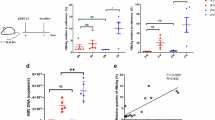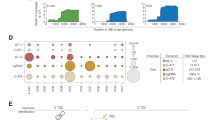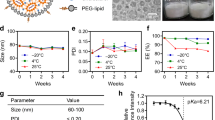ABSTRACT
Enhancer II (ENII) is one of the critical cis-elements in the Hepatitis B Virus (HBV) genome for the hepatic viral gene transcription and DNA replication. The liver-specific activity of ENII is regulated by multiple liver-enriched transcription factors, including LRH-1/hB1F, HNF1, HNF3β, HNF4 and C/EBP. Knowledge on the interplay of these important factors is still limited. In this study, we demonstrate a functional synergism between the orphan nuclear receptor LRH-1/hB1F and the homeoprotein HNF1 in up-regulating the liver-specific activity of ENII. This synergism is sufficient for initiating the viral gene transcription and DNA replication in non-hepatic cells. We have defined the activation domains in hB1F and HNF1 that contribute to the synergism. We further show that hB1F and HNF1 can interact directly in vitro and have mapped the domains required for this interaction.
Similar content being viewed by others
Log in or create a free account to read this content
Gain free access to this article, as well as selected content from this journal and more on nature.com
or
Abbreviations
- hB1F:
-
hepatitis B virus enhancer II B1 binding factor
- LRH-1:
-
liver receptor homologue-1
- HNF1:
-
hepatocyte nuclear factor 1
- HBV:
-
hepatitis B virus
- Cp:
-
core promoter
- ENII:
-
enhancer II
- AD:
-
activation domain
- DBD:
-
DNA binding domain
- LBD:
-
ligand binding domain
References
Wang Y, Chen P, Wu X, et al. A new enhancer element, ENII, identified in the X gene of hepatitis B virus. J Virol 1990; 64:3977–81.
Yee JK . A liver-specific enhancer in the core promoter region of human hepatitis B virus. Science 1989; 246:658–61.
Li M, Xie YH, Kong YY, Wu X, Zhu L, Wang Y . Cloning and characterization of a novel human hepatocyte transcription factor, hB1F, which binds and activates enhancer II of hepatitis B virus. J Biol Chem 1998; 273:29022–31.
Gilbert S, Galarneau L, Lamontagne A, Roy S, Belanger L . The hepatitis B virus core promoter is strongly activated by the liver nuclear receptor fetoprotein transcription factor or by ectopically expressed steroidogenic factor 1. J Virol 2000; 74:5032–9.
Li M, Xie YH, Wu X, Wang Y . HNF3 binds and activates the second enhancer, ENII, of hepatitis B virus. Virology 1995; 214:371–8.
Guo W, Chen M, Yen TS, Ou JH . Hepatocyte-specific expression of the hepatitis B virus core promoter depends on both positive and negative regulation. Mol Cell Biol 1993; 13:443–8.
Lopez-Cabrera M, Letovsky J, Hu KQ, Siddiqui A . Multiple liver-specific factors bind to the hepatitis B virus core/pregenomic promoter: trans-activation and repression by CCAAT/enhancer binding protein. Proc Natl Acad Sci USA 1990; 87:5069–73.
Raney AK, Johnson JL, Palmer CN, McLachlan A . Members of the nuclear receptor superfamily regulate transcription from the hepatitis B virus nucleocapsid promoter. J Virol 1997; 71:1058–71.
Wang WX, Li M, Wu X, Wang Y, Li ZP . HNF1 is critical for the liver-specific function of HBV enhancer II. Res Virol 1998; 149:99–108.
Xie Y, Li M, Wang Y, Hofschneider PH, Weiss L . Site specific mutation of the hepatitis B virus enhancer II B1 element: effect on virus transcription and replication. J Gen Virol 2001; 82: 531–5.
Nitta M, Ku S, Brown C, Okamoto AY, Shan B . CPF: an orphan nuclear receptor that regulates liver-specific expression of the human cholesterol 7alpha-hydroxylase gene. Proc Natl Acad Sci USA 1999; 96:6660–5.
Frain M, Swart G, Monaci P, Nicosia A, Staempfli S, Frank R, Cortese R . The liver-specific transcription factor LF-B1 contains a highly diverged homeobox DNA binding domain. Cell 1989; 59:145–57.
Baumhueter S, Mendel DB, Conley PB, et al. HNF-1 shares three sequence motifs with the POU domain proteins and is identical to LF-B1 and APF. Genes Dev 1990; 4:72–9.
Cai YN, Li M, Zhou Q, Kong YY, Wang Y . hB1F and HNF1 work synergistically in the regulation of the activity of HBV ENII. Chinese Science Bulletin 2000; 45:35–9.
Sambrook J, Fritsch EF, Maniatis T . Molecular cloning, cold spring harbor laboratory, cold spring harbor, New York, 1989.
Gorman CM, Moffat LF, Howard BH . Recombinant genomes which express chloramphenicol acetyltransferase in mammalian cells. Mol Cell Biol 1982; 2:1044–51.
Yu XM, Mertz JE . Critical roles of nuclear receptor response elements in replication of hepatitis B virus. J Virol 2001; 75:11354–64.
Fu L, Cheng YC . Role of additional mutations outside the YMDD motif of hepatitis B virus polymerase in L (-) SddC (3TC) resistance. Biochem. Pharmacol 1998; 55:1567–72.
Feng Y, Kong YY, Wang Y, Qi GR . Inhibition of hepatitis B virus by hammerhead ribozyme targeted to the poly(A) signal sequence in cultured cells. Biol Chem. 2001; 382:655–60.
Cereghini S, Yaniv M, Cortese R . Hepatocyte dedifferentiation and extinction is accompanied by a block in the synthesis of mRNA coding for the transcription factor HNF1/LGB1. EMBO J 1990; 9:2257–63.
Wu X, Zhu L, Li ZP, Koshy R, Wang Y . Functional organization of Enhancer (ENII) of hepatitis B Virus. Virology 1992; 191:490–4.
Tang H, McLachlan A . Transcriptional regulation of hepatitis B virus by nuclear hormone receptors is a critical determinant of viral tropism. Proc Natl Acad Sci USA 2001; 98:1841–6.
Raney AK, Easton AJ, Milich DR, McLachlan A . Promoterspecific transactivation of hepatitis B virus transcription by a glutamine- and proline-rich domain of hepatocyte nuclear factor 1. J Virol 1991; 65:5774–81.
Nicosia A, Monaci P, Tomei L, et al. A myosin-like dimerization helix and an extra-large homeodomain are essential elements of the tripartite DNA binding structure of LFB1. Cell 1990; 61:1225–36.
Bach I, Yaniv M . More potent transcriptional activators or a transdominant inhibitor of the HNF1 homeoprotein family are generated by alternative RNA processing. EMBO J 1993; 12:4229–42.
Moras D, Gronemeyer H . The nuclear receptor ligand-binding domain: structure and function. Curr Opin Cell Biol 1998; 10:384–91.
Torchia J, Glass C, Rosenfeld MG . Co-activators and co-repressors in the integration of transcriptional responses. Curr. Opin. Cell Biol 1998; 10:373–83.
Soutoglou E, Papafotiou G, Katrakili N, Talianidis I . Transcriptional activation by hepatocyte nuclear factor-1 requires synergism between multiple coactivator proteins. J Biol Chem. 2000; 275:12515–20.
Kakizawa T, Miyamoto T, Ichikawa K, et al. Functional interaction between Oct-1 and retinoid X receptor. J Biol Chem 1999; 274:19103–8.
Acknowledgements
The authors are grateful to Dr. E Lai for the pCMVpoly vector, Dr. M YANIV for the HNF1 expression plasmid and Dr. XM Yu for the pWT. This work is supported by the National Natural Science Foundation of China (30100088), High Technology Research and Development Project (2001-AA221261) and Basic Research Program from Ministry of Science and Technology (G19990 54105). Y Xie is supported by a Qi Ming Xing program (01QA14046) from Shanghai Science and Technology Committee. M Li is supported by a fellowship for outstanding Ph.D students from the Chinese Academy of Sciences.
Author information
Authors and Affiliations
Corresponding author
Rights and permissions
About this article
Cite this article
CAI, Y., ZHOU, Q., KONG, Y. et al. LRH-1/hB1F and HNF1 synergistically up-regulate hepatitis B virus gene transcription and DNA replication. Cell Res 13, 451–458 (2003). https://doi.org/10.1038/sj.cr.7290187
Received:
Revised:
Accepted:
Issue date:
DOI: https://doi.org/10.1038/sj.cr.7290187
Keywords
This article is cited by
-
Genome-wide association study of prevalent and persistent cervical high-risk human papillomavirus (HPV) infection
BMC Medical Genetics (2020)
-
Integrated Analysis of Copy Number Variations and Gene Expression Profiling in Hepatocellular carcinoma
Scientific Reports (2017)



